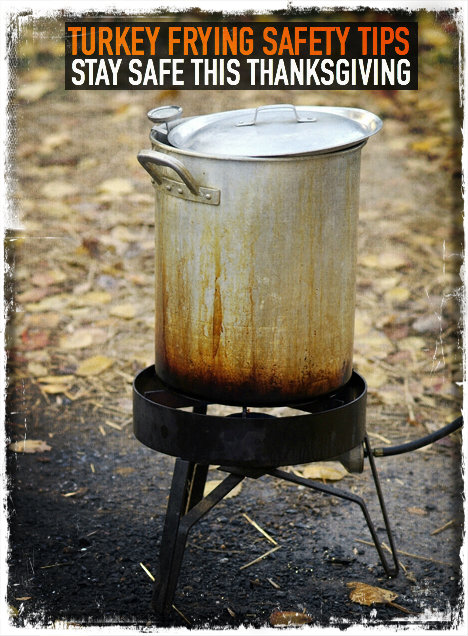
Just in case you have forgotten, the following is a reminder. Every year deaths are attributed to turkey frying, but injury and death can be prevented with some common sense and attention to detail and by knowing the facts.
In the days and weeks leading up to Thanksgiving there are television ads warning of the dangers of turkey frying, the Allstate Insurance ad comes to mind. Despite all the warnings on television and warning labels on fryers, people still manage to ruin their turkey, destroy their fryer, burn themselves and in some cases even burn the house down.
Frozen turkeys placed in a fryer with hot oil will create an explosion of hot oil. The turkey must be thoroughly defrosted and then patted down with paper towel to remove any water before cooking in oil.
Anyone that has cooked in hot oil knows that water and other liquids do not mix well with hot oil. This is why a frozen turkey can create havoc if you place it in hot oil. Frozen means water and water will cause the fryer oil to boil over the top of the fryer. If using a propane fryer the oil will reach the flames, and then you have a disaster on your hands, a dangerous one. Of course, hot oil boiling over anywhere will create a crisis and you can be seriously burned, so do it right so there is no need to worry.
Thaw the Bird Safely In the Refrigerator
Safe thawing is not tossing the frozen bird under the back windshield or leaving on the back seat or in the trunk. Yes, people have done this along with leaving it on the counter for several days, or even soaking it in hot water. If it can be done in an unsafe manner then someone, somewhere has done it.
According to the USDA the proper thaw times for a frozen turkey by weight is as follows. The turkey must be thawed in the refrigerator at 40ᵒ F or below but obviously above 32ᵒ F, which is the temperature at which water freezes. The turkey must be in a container that prevents the juices from contaminating other foods.
- 4 to 12 pounds — 1 to 3 days
- 12 to 16 pounds — 3 to 4 days
- 16 to 20 pounds — 4 to 5 days
- 20 to 24 pounds —5 to 6 days
Thaw by Immersing In Cold Water
Turkeys can also be thawed by sealing the frozen bird in a bag that prevents water from touching the turkey and immersing in cold water. The recommended times are based on 30 minutes per pound. Every thirty minutes change the water.
- 4 to 12 pounds — 2 to 6 hours
- 12 to 16 pounds — 6 to 8 hours
- 16 to 20 pounds — 8 to 10 hours
- 20 to 24 pounds — 10 to 12 hours
Safe to Eat Temperatures
The minimum temperature is 165ᵒ F and the same applies to any stuffing. Most stuffing would include raw eggs and can include parts of the turkey, sausage, oysters and so on, so the internal temperature must reach 165 degrees as well. It is not recommend that you stuff the turkey with raw stuffing and then cook inside the bird, but if you do again check, the internal temperature to ensure it is at a minimum of 165 degrees.
The stuffing in some cases will not get hot enough deep inside the bird, even when cooked for hours, so bacteria could still be present. You can cook the stuffing ahead of time and then stuff or at the least cook any raw meats before adding to the stuffing.
No raw foods should be left out of refrigeration longer than two hours because of bacteria growth.
Never use a propane turkey fryer inside the home, and any large fryer should be used outside away from the home and any wood structures in the event the oil does boil over. Some fryers can use up to five gallons of oil and turkey fries at 350ᵒ F. Flames and oil can be a deadly combination.
Common Sense
According to the National Fire Protection Association (NFPA), cooking is and has been the leading cause of home structure fires. Home fires due to cooking increase over the Thanksgiving Holiday, so do not become a statistic this year or any year after.
Sources:
http://www.nfpa.org/research/reports-and-statistics/fire-causes/appliances-and-equipment/cooking-equipment
http://www.fsis.usda.gov/wps/portal/fsis/topics/food-safety-education/get-answers/food-safety-fact-sheets/poultry-preparation/turkey-basics-safe-thawing/CT_Index